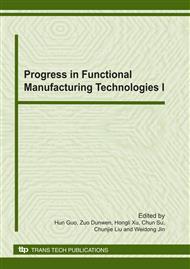[1]
Robert Frosch and Nicholas Gallopoulos: Strategies for Manufacturing. Scientific American Vol. 261 (1989), p.144–152.
DOI: 10.1038/scientificamerican0989-144
Google Scholar
[2]
Ehrenfeld J, Gertler N: The evolution of interdependence at Kalundborg. Journal of Industrial Ecology Vol. 1 (1997) , p.67–80.
Google Scholar
[3]
Jianxin Yang and Rusong Wang: Retrospect and prospect of industrial ecology. CHINESE JOURNAL OF APPL IED ECOLOGY Vol. 5 (1998), p.555~561(In Chinese).
Google Scholar
[4]
In Industrial Ecology and the Sustainability of Canadian Cities. Information on http: /eco-efficiency. management. dal. ca/index. htm.
Google Scholar
[5]
Graedel TE. 1996. On the concept of industrial ecology Annual Review of Energy Environment Vol. 21 (1996), p.69–98.
DOI: 10.1146/annurev.energy.21.1.69
Google Scholar
[6]
R. Hiejungs, J. B. Guinee, G. Huppes, R. M. Lankreijer, H. S. Udo de Haes, A. Wegener Sleeswijk, A. M. M. Ansems, P. G. Eggels, R. van Duin, and de Goede: Environmental Life Cycle Assessment of Products—Back- grounds, (Leiden, Netherlands: Center of Environmental Science) (1992).
DOI: 10.1007/0-306-48055-7_22
Google Scholar
[7]
Eilering JAM, Vermeulen WJV. Eco-industrial parks: toward industrial symbiosis and utility sharing in practice, Progress in Industrial Ecology Vol. 1(2004), p.245–270.
DOI: 10.1504/pie.2004.004681
Google Scholar
[8]
Illge L, Schwarze R.: A Matter of Opinion: How Ecological and Neoclassical Environmental Economists Think about Sustainability and Economics . German Institute for Economic Research (2006).
DOI: 10.1016/j.ecolecon.2008.08.010
Google Scholar
[9]
Ehrenfeld J: Industrial ecology; a framework for product and process design. Journal of Cleaner Production Vol. 5 (1997), p.87–96.
Google Scholar
[10]
Jelinski LW, Graedel TE, Laudise RA, McCall DW, Patel CKN: Industrial ecology: concepts and approaches. Proceedings of the National Academy of Sciences Vol. 89 (1992. ): 793–797.
DOI: 10.1073/pnas.89.3.793
Google Scholar
[11]
Y. Q. Tang and M. L. Zhang, A Brief Evaluation of Jiangxi Hengfeng Eco-Industrial Park Based on Green Manufacturing. Journal of Key Engineering Materials Vols. 426-427(2010), pp.182-185.
DOI: 10.4028/www.scientific.net/kem.426-427.182
Google Scholar


